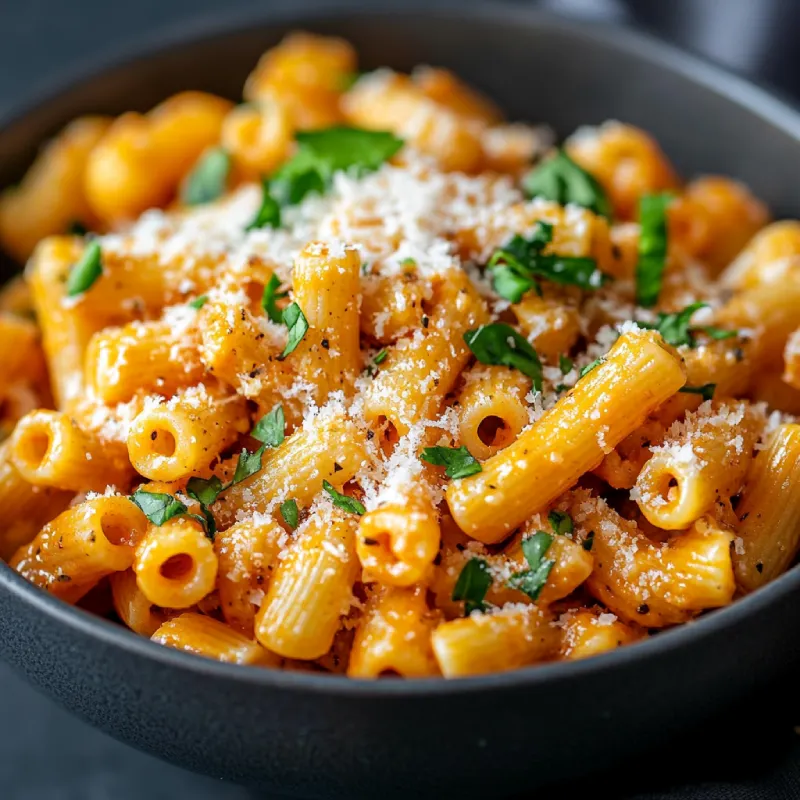Introduction to Ditalini Pasta
Ditalini pasta, known for its small tube-like shape, is a staple in many Italian kitchens. The name “ditalini” translates to “little thimbles” in Italian, reflecting its distinctive and charming appearance. This pasta variety is famously used in a range of soups and stews due to its size, which allows it to blend harmoniously with other ingredients without overpowering them.
Characteristics and Culinary Uses
- Shape and Size: Ditalini is characterized by its short tube shape, making it perfect for capturing flavors in its hollow center.
- Culinary Versatility: Beyond soups, such as the classic Pasta e Fagioli, ditalini works well in salads, baked dishes, and even risotto-style preparations where its ability to absorb flavors comes to the forefront.
Ditalini’s role in Italian cuisine cannot be overstated. It is particularly valued in dishes that require the pasta to meld well with legumes and vegetables, often served in brothy or creamy environments. Whether in a simple light broth with vegetables or paired with rich sauces and meats, ditalini provides a satisfying bite and a comforting mouthfeel.
Classic Ditalini Pasta Recipes
Ditalini pasta is integral to several classic Italian dishes, revered for its delightful compatibility with soups and stews due to its small, tubular shape. Two standout dishes that traditionally feature ditalini are Pasta e Fagioli and Minestrone.
Pasta e Fagioli
This comforting dish translates to “pasta and beans” and is a staple in Italian cuisine, known for its hearty and satisfying nature. It combines ditalini pasta with cannellini beans, tomatoes, and aromatics, simmered in a savory broth. Here’s a simple way to bring this recipe to your kitchen:
- Ingredients: Olive oil, minced garlic, chopped onion, diced celery, diced carrots, cannellini beans, crushed tomatoes, chicken or vegetable broth, ditalini pasta, salt, pepper, and a pinch of red pepper flakes.
- Preparation: Begin by sautéing onions, garlic, celery, and carrots in olive oil. Add tomatoes, beans, and broth, bringing to a simmer. Stir in the pasta and cook until al dente. Season with salt, pepper, and red pepper flakes.
Minestrone
Minestrone is a vibrant vegetable soup that features a medley of seasonal vegetables, stock, and ditalini pasta, often enriched with parmesan cheese and herbs.
- Ingredients: Olive oil, onion, garlic, seasonal vegetables (like zucchini, carrots, and spinach), diced tomatoes, vegetable or chicken broth, ditalini pasta, and herbs (basil or parsley).
- Preparation: Sauté onions and garlic in olive oil. Add other chopped vegetables, cooking until softened. Pour in tomatoes and broth, simmering until vegetables are tender. Add ditalini, cooking until pasta is tender. Finish with fresh herbs and season to taste.
Step-by-Step Basic Ditalini Pasta Dish
For a simple ditalini dish that you can whip up any night of the week, follow these steps:
- Ingredients: Ditalini pasta, olive oil, garlic, cherry tomatoes, spinach, salt, pepper, and grated Parmesan cheese.
- Instructions:
- Cook Pasta: Boil ditalini in salted water until al dente, then drain.
- Sauté Flavor Bases: In a skillet, heat olive oil and sauté minced garlic until fragrant.
- Add Vegetables: Toss in halved cherry tomatoes and spinach, cooking until the spinach wilts.
- Combine: Mix the cooked pasta with the vegetables in the skillet. Season with salt and pepper.
- Serve: Sprinkle with Parmesan before serving.
These recipes showcase ditalini pasta’s versatility and its ability to absorb and complement the flavors of various ingredients.
Ditalini in Soups and Stews
Ditalini pasta, with its petite size and substantial texture, is an ideal choice for adding body to soups and stews. Its ability to absorb flavors while maintaining a pleasing bite makes it a favorite in kitchens that cherish hearty, comforting meals.
Incorporating Ditalini into Soups
- Soup Recipes: Ditalini is a star in classic recipes like Minestrone or Pasta e Fagioli. Its small size ensures that each spoonful comes with a burst of pasta, making these dishes both filling and flavorful.
- Cooking Methods: To best incorporate ditalini into soups, add the pasta towards the end of the cooking process. This helps prevent it from becoming too soft and allows it to absorb the flavors of the broth effectively.
Ditalini in Hearty Stews
- Stew Recipes: In thicker stews, ditalini provides a satisfying chewiness that complements tender chunks of meat or vegetables. It works particularly well in tomato-based stews where its absorbency enhances its taste and texture.
- Preparation Tips: For stews, consider pre-cooking the ditalini to just under al dente before adding it to the stew. This technique helps manage the cooking process and ensures the pasta doesn’t overcook during the simmering stage.
Highlighting the Pasta’s Qualities
- Flavor Absorption: One of the hallmarks of ditalini is its ability to soak up and amplify the flavors it’s cooked with, thanks to its hollow shape and robust texture.
- Texture in Dishes: Whether in a brothy soup or a dense stew, ditalini adds a delightful bite that is both comforting and satisfying, enhancing the overall mouthfeel of the dish.
By understanding these aspects of ditalini, you can better utilize this pasta in various cooking styles, from quick weeknight soups to slow-cooked weekend stews.
Innovative Ditalini Dishes
Ditalini pasta, typically reserved for soups and stews, is remarkably versatile and can be used in a range of creative dishes. From risottos to salads, this small pasta introduces texture and flavor that can transform ordinary recipes into something extraordinary.
Ditalini Risottos
- Concept: Unlike traditional risottos made with rice, ditalini risottos use this pasta as the starch base, which absorbs flavors while offering a unique, toothsome bite.
- Preparation: Begin by sautéing onions and garlic, then add the ditalini, toasting slightly before deglazing with white wine. Gradually add warm broth to the pasta, stirring continuously until creamy and al dente.
Ditalini Salads
- Summer Salad Ideas: Toss cooked ditalini with fresh vegetables like cherry tomatoes, cucumbers, and arugula. Dress with a light vinaigrette and top with crumbled feta or goat cheese for a refreshing meal.
- Warm Salad Concepts: Combine ditalini with roasted vegetables and a balsamic reduction. Serve warm with shaved Parmesan for a hearty side dish.
Creative Pairings
- With Various Sauces:
- Pesto: Blend basil, garlic, pine nuts, and Parmesan with olive oil for a vibrant, herby coating on ditalini.
- Tomato-based sauces: Simmer cherry tomatoes with garlic and herbs until burst, then toss with ditalini and fresh basil.
- With Proteins:
- Integrate chunks of grilled chicken or flaked salmon into a ditalini salad for added protein.
- Stir crispy pancetta or bacon into warm ditalini dishes for a savory flavor boost.
Tips for Pairing Ditalini
- Flavor Balance: Consider the balance of flavors when adding ingredients—ditalini works well with both bold and subtle flavors, but it’s important not to overpower its delicate texture.
- Sauce Consistency: Opt for thicker, creamier sauces that cling to the small tubes of the pasta, enhancing every bite with flavor.
By exploring these innovative uses for ditalini, you can expand your culinary repertoire and delight in new and unexpected ways to enjoy this versatile pasta.
Ditalini Pasta Salads
Ditalini pasta, with its small, tube-like shape, is ideal for cold pasta salads, providing a perfect bite-sized component that melds seamlessly with a variety of mix-ins and dressings. These salads are excellent for picnics, potlucks, and family gatherings.
Creating the Perfect Pasta Salad
- Cooking Ditalini: Boil the pasta until it is al dente, then rinse under cold water to stop the cooking process and remove excess starch. This ensures the pasta remains firm and doesn’t get mushy when mixed with other ingredients.
- Choosing Mix-ins:
- Vegetables: Cherry tomatoes, cucumbers, bell peppers, and red onions add crunch and color.
- Proteins: Canned tuna, cooked chicken, or chickpeas offer satisfying protein options.
- Cheese: Cubes of feta, shredded mozzarella, or parmesan add a creamy texture and salty flavor.
Dressing Types and Pairing Ideas
- Vinaigrette Options:
- A simple Italian vinaigrette, combining olive oil, vinegar, mustard, and Italian herbs, complements the neutral taste of ditalini well.
- For a zestier flavor, whisk together lemon juice, olive oil, garlic, and a touch of honey.
- Creamy Dressings:
- A buttermilk ranch or a Caesar dressing can provide a rich coating that clings nicely to the pasta, enhancing each bite.
Tips for Assembling
- Tossing the Salad: Combine the cooked pasta with your choice of mix-ins. Pour the dressing over the salad and toss gently to ensure that everything is evenly coated.
- Chilling: Allow the salad to chill in the refrigerator for at least an hour before serving. This helps the flavors to meld together and enhances the overall taste.
Ditalini pasta salads are not only easy to prepare but also customizable to fit any taste preference or dietary need, making them a go-to choice for any occasion.
Baked Ditalini Recipes
Baked ditalini recipes provide a delightful twist to traditional pasta dishes, particularly through casseroles and pasta bakes that are perfect for feeding a crowd or enjoying as comfort food.
Exploring Baked Ditalini Dishes
- Ditalini Casseroles: Often combined with rich sauces, cheeses, and proteins such as chicken, ground beef, or sausage, ditalini makes an excellent base for hearty casseroles.
- Pasta Bakes: Similar to casseroles but often featuring a crispier top layer of breadcrumbs or extra cheese, ditalini pasta bakes are a hit at any gathering due to their appealing texture and deep flavors.
Techniques for Perfect Bake Consistency
- Pre-cooking Pasta: To avoid mushy pasta, cook ditalini until just under al dente before baking. It will continue to soften in the oven.
- Layering Ingredients: For even cooking and flavor distribution, layer your ingredients thoughtfully. Start with a layer of pasta, add your sauce and fillings, then top with cheese and breadcrumbs.
- Baking Tips:
- Temperature: Bake at a moderate temperature (around 350°F or 175°C) to allow the dish to heat through without burning the top.
- Covering During Baking: Covering the dish with foil for part of the baking time can prevent excessive browning on top. Remove the cover in the last 10-15 minutes to allow the surface to get crispy.
Ditalini pasta, with its small size and substantial texture, excels in baked dishes, making it a versatile choice for meals that require both comfort and sophistication.
FAQs: Cooking and Storing Ditalini Pasta
Common Questions About Cooking Ditalini Pasta
- How long should I cook ditalini pasta? Ditalini pasta typically cooks in about 8-10 minutes. Start checking for doneness around the 8-minute mark to ensure it reaches al dente texture.
- What is the best method for achieving al dente texture? To achieve perfect al dente ditalini, use plenty of boiling water with a good amount of salt, stir the pasta occasionally to prevent sticking, and taste test it a minute before the recommended cooking time.
Tips for Storing and Reheating Ditalini Dishes
- Storing Cooked Ditalini: Cool the pasta down quickly after cooking and store it in an airtight container in the refrigerator. It should last for up to 5 days.
- Reheating: To reheat, sprinkle some water over the pasta to prevent it from drying out and microwave it covered. For oven reheating, place it in an oven-safe dish, cover with aluminum foil, and heat at 350°F until warm.
Conclusion
Cooking ditalini pasta correctly ensures a pleasurable eating experience, and proper storage and reheating methods help maintain its quality. Whether enjoyed fresh or as leftovers, ditalini offers versatility and satisfaction in a variety of dishes.

